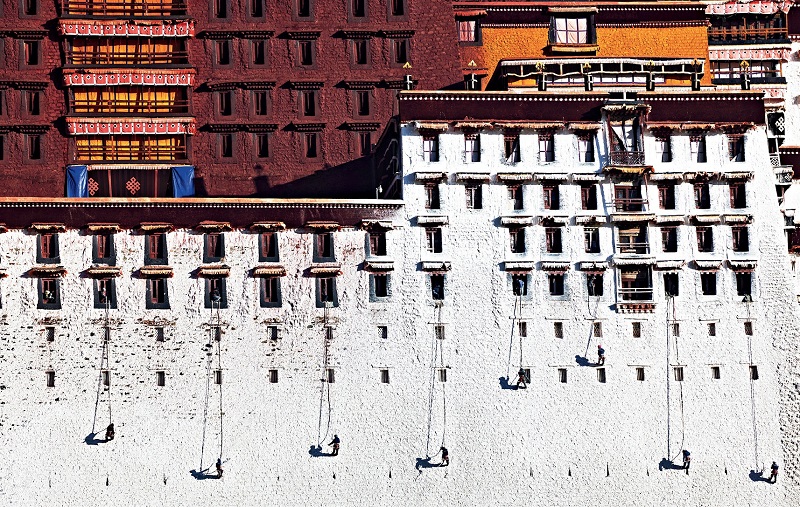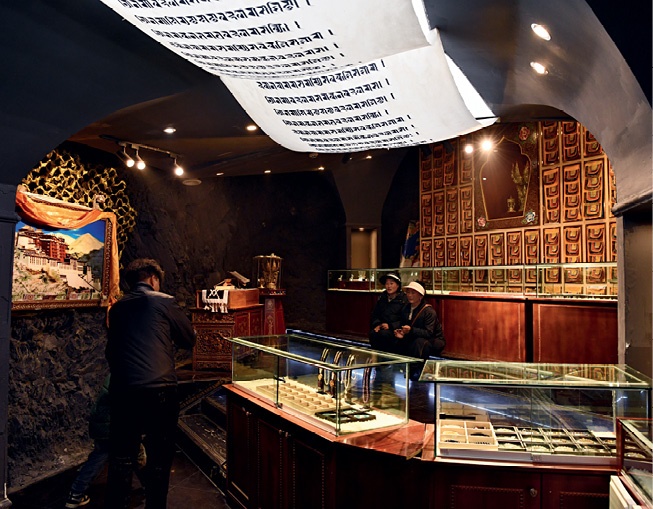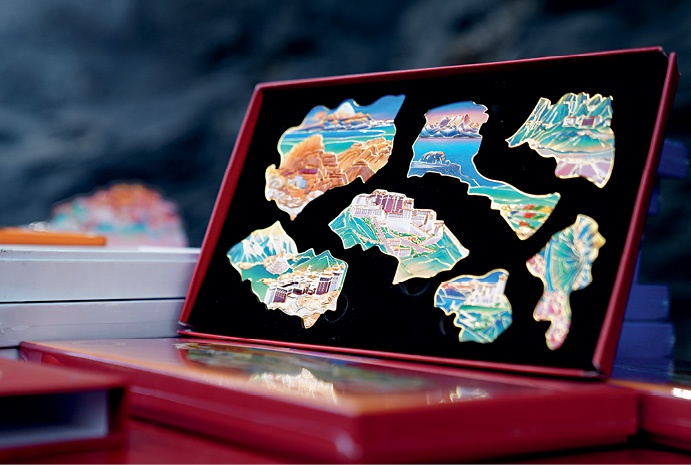The Potala Palace is not only a sacred place in the hearts of Tibetan people but also a world-renowned tourist destination. From its mysterious past to today’s openness and inclusiveness, the palace has embarked on a distinctive path of “dynamic preservation.”

Professional workers, acting like “spidermen,” repaint the Potala Palace.
The unique charm of the Potala Palace has always captivated people from around the world. Today, this iconic landmark in Lhasa perched on the “roof of the world” has become a must-visit destination for anyone visiting Xizang.
From its mysterious past to today’s openness and inclusiveness, the palace has embarked on a distinctive path of “dynamic preservation.” It has struck a perfect balance between cultural heritage protection and development, setting a model for the sustainable development of world cultural heritage.

The fabric hanging from the ceiling of the cultural and creative experience hall has texts of the palm-leaf manuscripts printed on them, aiming to promote public awareness and protection of the ancient scriptures.
Xuecheng: From Home Courtyard to World Cultural Heritage Site
As visitors enter the Potala Palace from the south gate, they are greeted by two large wooden doors that bear the marks of time, and four closely connected pillars support the long eaves above. Passing through this gate, visitors then enter a 50,000-square-meter courtyard at the base of the palace, known as Xuecheng.
“If you want to really understand the Potala Palace, Xuecheng is an essential starting point,” said Tenzin Dorje, a section director of the Potala Palace Management Office. In the Tibetan language, “xue” means “below,” and Xuecheng refers to the area enclosed by walls at the base of the time-honored Potala Palace. The residents who used to live here are called Xueba, meaning “people of Xue-cheng.” Until the construction of the new Xuecheng Village in the 1990s, many Xuebas still lived in the old complex, providing various services for the palace for generations.
The history of the courtyard can be traced back to the 17th century. Architecturally, it is considered an auxiliary yet indispensable part of the Potala Palace. The buildings within the city are diverse in type and rich in character, including offices of the former local Xizang government, luxurious residences of aristocrats and officials, dwellings for lower-ranking staff, craftsmen, and serfs, as well as service facilities. These buildings jointly paint a vivid historical picture of Xuecheng.
However, with the passing of time, it has weathered damage from the elements. To protect this precious cultural heritage, large-scale restoration and protection projects were launched for the Potala Palace and the area surrounding it in 1989. During this process, over 100 households living within Xuecheng were relocated. In 1994, for construction of the Potala Palace Square, more than 300 households outside the courtyard walls were also relocated. In 2002, the last residents of Xuecheng left the homes they had lived in for generations and moved into the newly built Xuecheng New Village.
In order to protect these ancient buildings and cultural heritage at Xuecheng, the Chinese government invested substantial financial and human resources between 2002 to 2006 into restoring and preserving 22 existing buildings. In 2007, Xuecheng was officially opened to the public, showcasing its unique charm that combined the dynamic display of the original and restored architectural elements, and special exhibitions. Meanwhile, the establishment of the Treasure Hall of the Potala Palace and the Tourist Service Center have greatly enriched the experience for tourists.
For former residents of Xuecheng, their living conditions have significantly improved. The new village is fully equipped with modern facilities, enabling residents to preserve and better enjoy their cultural traditions in a new environment.
Today, as an ancient architectural complex with profound historical heritage and cultural value, Xuecheng remains an important cultural heritage site and a popular tourist destination in Xizang. Since the Potala Palace was added to the UNESCO World Heritage List in 1994, its international reputation has risen significantly, and it has attracted countless tourists from around the world, serving as a bridge between the past and the present. Over the past 30 years, the number of tourists that have visited the Potala Palace has grown from fewer than 50,000 in 1990 to 2.2 million in 2024.

Tourists take a group photo at the Potala Palace Square in front of the Potala Palace.
Balancing Preservation with Tourism Development
A symbol of Xizang’s long history and rich culture, the Potala Palace is not only a sacred place in the hearts of people in Xizang but also a world-renowned tourist destination. With the opening of the Qinghai-Xizang Railway, Xizang’s tourism industry experienced rapid growth. But with the continuous surge in tourists to the Potala Palace, the growing tension between tourism demands and cultural heritage preservation came to the surface.
In recent years, the Potala Palace Administration Office has continued to explore new management methods and improve management efficiency. According to Tenzin Dorje, they commissioned the School of Civil Engineering at Beijing Jiaotong University to monitor the palace’s structural integrity. Based on years of scientific monitoring and big data checks, the palace’s maximum daily capacity was set to be no more than 5,000 people. To protect this precious cultural heritage, the Potala Palace introduced a tourist cap in 2003, becoming the first historical and cultural facility in China to do so.
Meanwhile, to alleviate the pressure of receiving large volumes of tourists, the palace implemented a time-slot ticketing system in 2018, and a limited number of tourists are allowed to enter every 20 minutes. This helps to control the number of people walking through the palace. Staff members also help guide and disperse tourists, and guided tours are restricted to one hour inside the main buildings.
In addition, the Potala Palace has opened tour route No. 2, which is activated when the full daily capacity of tourist route No. 1 is reached, so as to accommodate more tourists. Tenzin Dorje said that while these measures may cause certain inconveniences for tourists, most of them have expressed understanding and support, recognizing the need to protect this thousand-year-old architecture.
While ensuring the safety of the cultural relics, the Administration Office is also committed to improving the tourist experience. Through new media platforms such as the palace’s official website, WeChat, and Douyin, it actively shares information about the reasons for tourist limits, ticket booking procedures, pricing, tour guide services, and security checks, doing its part to make sure tourists are well-informed before they visit.
To meet the demands of foreign tourists, the Administration Office reserves 3,000 tickets each year for distribution through local tourism departments, ensuring that foreign tourists have the opportunity to appreciate the charm of the Potala Palace.
In response to growing tourism demands, supporting facilities around the Potala Palace have been continuously improved, with the renovation of Potala Palace Square completed in 2006 and the opening of the Tourist Service Center providing a more comfortable environment for tourists.
Tenzin Dorje said that the Potala Palace has found a balance between cultural heritage preservation and tourism development. Through a series of innovative management measures and improvements in supporting facilities, they have not only effectively protected this invaluable cultural heritage site but also enhanced the tourist experience. In the future, the Potala Palace will continue pursuing sustainable development that gives equal weight to preservation and development, allowing more people to learn about and appreciate the cultural charm and historical value of this thousand-year-old architecture.

Potala Palace-themed cultural and creative products and refrigerator magnets featuring scenic spots in Xizang.
Cultural and Creative Products Grow in Popularity
In an effort to balance tourism development with cultural heritage preservation, the Potala Palace has also made the development and promotion of cultural and creative products a key priority of its work. Located at the exit behind the Red Palace is a three-story teahouse of stone and wood structure featuring rich ethnic Tibetan characteristics. After it was renovated in 2019, it was transformed into the Potala Palace Cultural and Creative Experience Center. Cultural and creative products with Tibetan elements sold here have a strong commercial appeal.
This store offers a dazzling array of goods, including thangkas, tea sets, stationery, and fridge magnets. According to staff, most of the products are inspired by artifacts in the palace’s collection. Designers ingeniously incorporated Tibetan cultural elements into various objects. For instance, a silk scarf featuring Princess Wencheng’s journey to Xizang vividly portrays the grandeur of her arrival. Bookmarks inspired by Tibetan Opera masks preserve the unique essence of the art form while adding a touch of fun. Other bestsellers include sachet pendants infused with traditional Tibetan medicine, pillows shaped like Dzi beads, and fridge magnets featuring the Potala Palace with changeable background lighting.
Why are Potala Palace’s cultural and creative products so popular? Dargye, head of the Potala Palace Cultural and Creative Center, cited two main reasons. First, the products feature vivid designs and are rich in cultural connotations. Second, they are of excellent quality. “Our R&D team is ramping up efforts to produce new products at a faster pace to meet the growing demands of online and offline shoppers from home and abroad,” he said.
The store is more than just a shopping place. It is also an important window for promoting Tibetan culture. “Here, each cultural and creative product is a heartfelt interpretation of Tibetan culture. In the future, we’ll continue to explore the historical and cultural significance of the Potala Palace and apply modern design concepts and technologies in order to better bring cultural relics to life,” Dargye said.